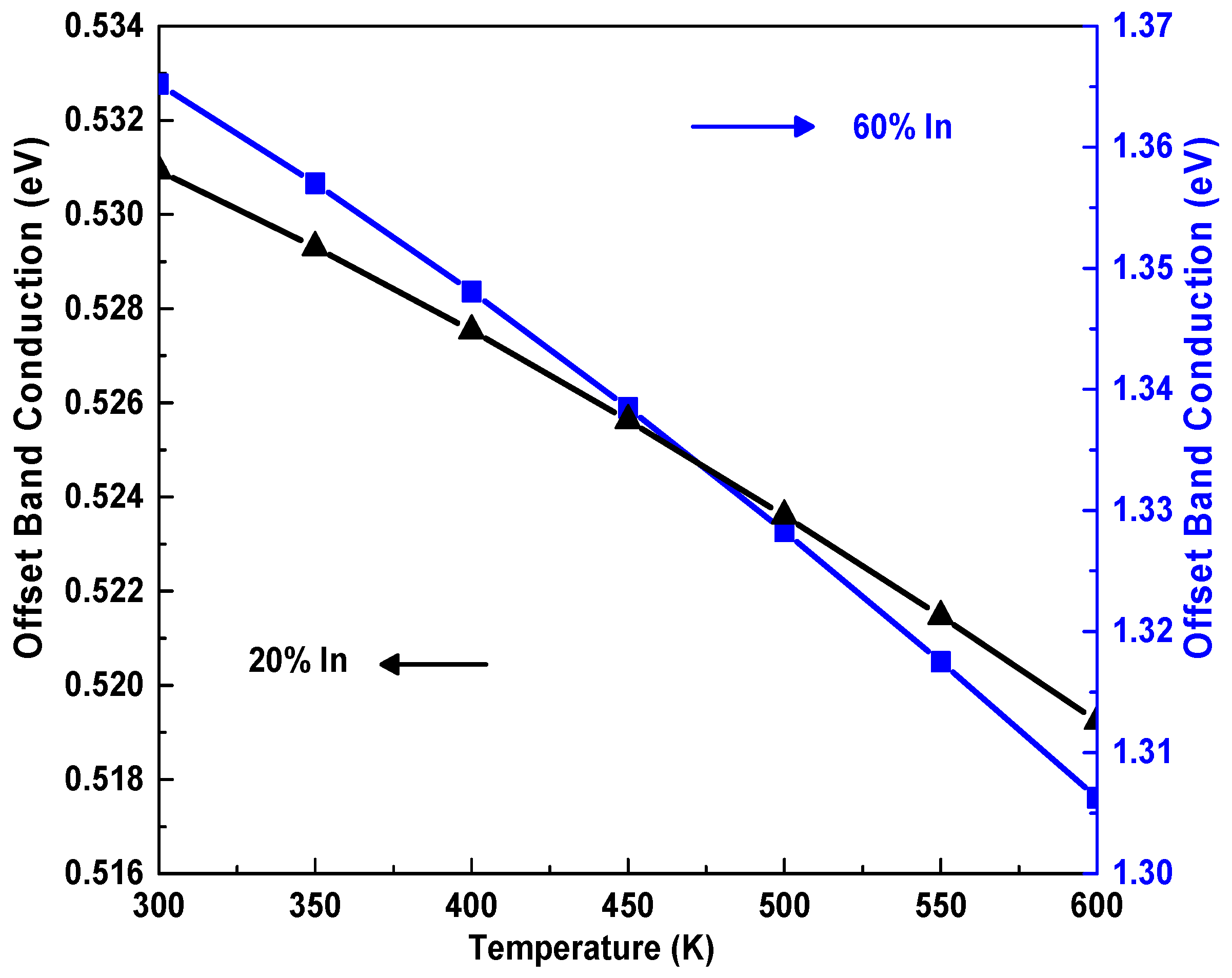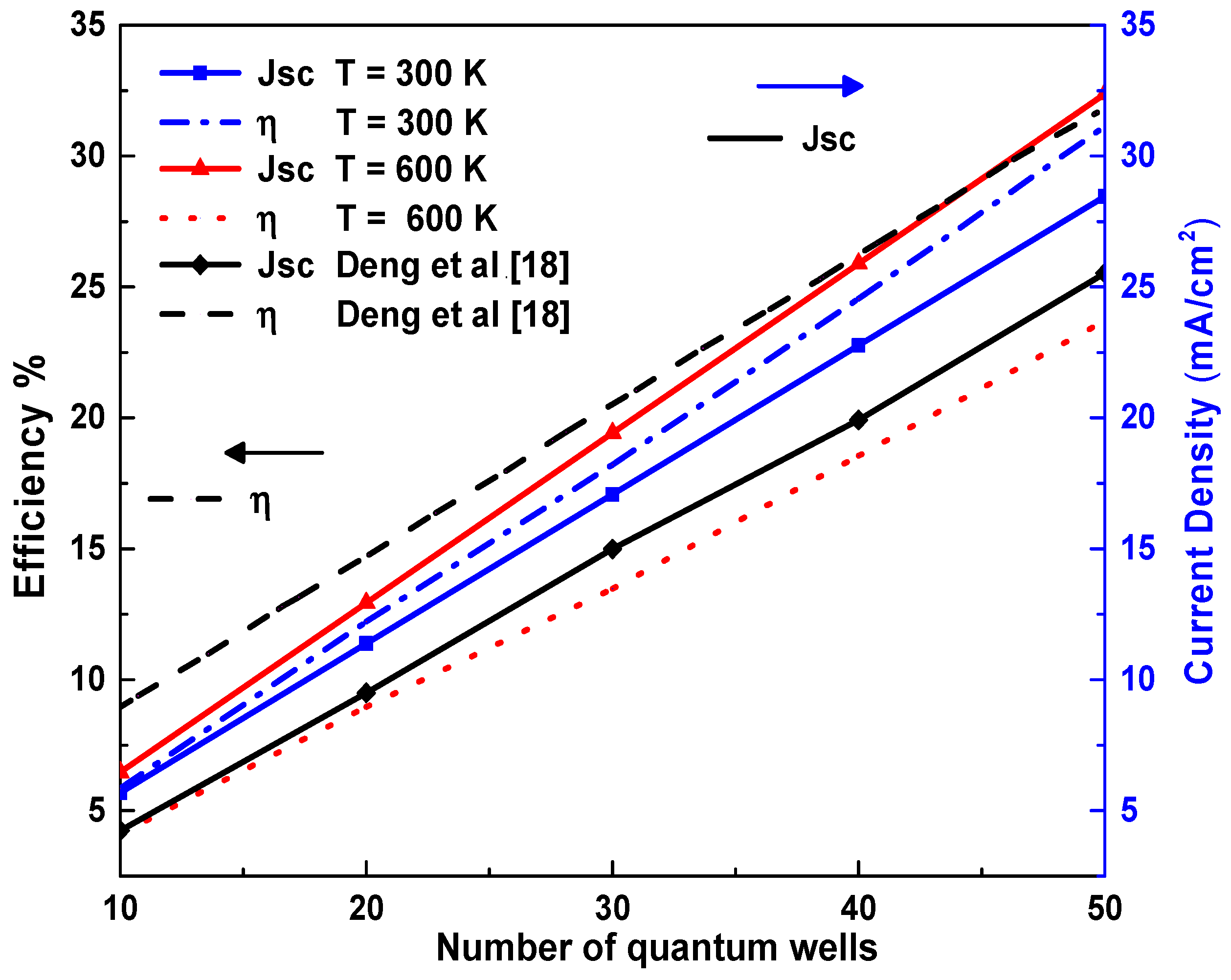Numerical Modeling of the Electronic and Electrical Characteristics of InGaN/GaN-MQW Solar Cells
Abstract
:1. Introduction
2. Governing Equations and Numerical Method
2.1. Description of the Structure
2.2. Electrical Parameters of the InGaN/GaN MQW-SC
2.3. Poisson-Schrodinger Equations:
2.4. Numerical Method
2.5. Boundary Conditions
3. Results and Discussion
- -
- The longitudinal profile of the conduction band energy along the growth direction z for the two values of the number of QWs and several values of the temperature;
- -
- The evolution of the conduction band offset ΔEc versus the temperature for several values of the indium content;
- -
- The variation of the Fermi energy and the 2DEG distribution at the interface versus the temperature, the indium content and the number of QWs;
- -
- The variation of the efficiency and short-circuit current density versus the number of QWs, the temperature, and In-content;
- -
- The dependence of the open circuit voltage versus the temperature.
4. Conclusions
Author Contributions
Funding
Acknowledgments
Conflicts of Interest
References
- Ambacher, O.; Majewski, J.; Miskys, C.; Link, A.; Hermann, M.; Eickhoff, M.; Stutzmann, M.; Bernardini, F.; Fiorentini, V.; Tilak, V.; et al. Pyroelectric properties of Al(In)GaN/GaN hetero—And quantum well structures. J. Phys. Condens. Matter. 2002, 14, 3399–3434. [Google Scholar] [CrossRef]
- Cai, X.M.; Zeng, S.W.; Li, X.; Zhang, J.Y.; Lin, S.; Lin, A.K.; Chen, M.; Liu, W.J.; Wu, S.X.; Zhang, B.P. Dependence of the property of InGaN p-i-n solar cells on the light concentration and temperature. IEEE Trans. Electron. Dev. 2011, 58, 3905–3911. [Google Scholar] [CrossRef]
- Wu, J.; Walukiewicz, W.; Yu, K.M.; Shan, W.; Ager, J.W. Superior radiation resistance of In1−xGaxNIn1−xGaxN alloys: Full-solar-spectrum photovoltaic material system. J. Appl. Phys. 2003, 94, 6477–6482. [Google Scholar] [CrossRef]
- Bhuiyan, G.; Sugita, K.; Hashimoto, A.; Yamamoto, A. InGaN solar cells: Present state of the art and important challenges. IEEE. J. Photovolt. 2012, 2, 276–293. [Google Scholar] [CrossRef]
- Barnham, K.W.J.; Duggan, G. A new approach to high-efficiency multi-band-gap solar cells. J. Appl. Phys. 1990, 67, 3490–3493. [Google Scholar] [CrossRef]
- Barnham, K.W.J.; Ballard, I.; Connolly, J.P.; Daukes, N.J.E.; Kluftinger, B.G.; Nelson, J.; Rohr, C. Quantum well solar cells. Phys. E Low Dimens. Sys. Nanos. 2002, 14, 27–36. [Google Scholar] [CrossRef]
- Dahal, R.; Li, J.; Aryal, K.; Lin, J.Y.; Jiang, H.X. InGaN/GaN multiple quantum well concentrator solar cells. Appl. Phys. Lett. 2010, 97, 073115. [Google Scholar] [CrossRef]
- Mesrane, A.; Mahrane, A.; Rahmoune, F.; Oulebsir, A. Temperature dependence of InGaN dual-junction solar cell. J. Electron. Mater. 2017, 46, 2451–2459. [Google Scholar] [CrossRef]
- Asgari, A.; Khalili, K. Temperature dependence of InGaN/GaN multiple quantum well based high efficiency solar cell. Sol. Energy Mater. Sol. Cells. 2011, 95, 3124–3129. [Google Scholar] [CrossRef]
- Jeng, M.J.; Lee, Y.L.; Chang, L.B. Temperature dependences of InxGa1− xN multiple quantum well solar cells. J. Phys. D Appl. Phys. 2009, 42, 105101. [Google Scholar] [CrossRef]
- Redaelli, L.; Mukhtarova, A.; Felip, S.V.; Ajay, A.; Bougerol, C.; Himwas, C.; Vincent, J.F.; Durand, C.; Eymery, J.; Monroy, E. Effect of the quantum well thickness on the performance of InGaN photovoltaic cells. Appl. Phys. Lett. 2014, 105, 131105. [Google Scholar] [CrossRef] [Green Version]
- Watanabe, N.; Yokoyama, H.; Shigekawa, N.; Sugita, K.; Yamamoto, A. Barrier thickness dependence of photovoltaic charateristics of InGaN/GaN multiple quantum well solar cells. Jpn. J. Appl. Phys. 2012, 51, 10ND10. [Google Scholar] [CrossRef]
- Wierer, J.J.; Koleske, D.D.; Lee, S.R. Influence of barrier thickness on the performance of InGaN/GaN multiple quantum well solar cells. Appl. Phys. Lett. 2012, 100, 111119. [Google Scholar] [CrossRef]
- Lai, K.Y.; Lin, G.J.; Lai, Y.L.; Chen, Y.F.; He, J.H. Effect of indium fluctuation on the photovoltaic characteristics of InGaN/GaN multiple quantum well solar cells. Appl. Phys. Lett. 2010, 96, 081103. [Google Scholar] [CrossRef]
- Felip, S.V.; Mukhtarova, A.; Pan, Q.; Altamura, G.; Grenet, L.; Durand, C.; Bougerol, C.; Peyrade, D.; Posada, F.G.; Eymery, J.; et al. Photovoltaic response of InGaN/GaN multiple-quantum well solar cells. Jpn. J. Appl. Phys. 2013, 52, 08JH05. [Google Scholar] [CrossRef]
- Felip, S.V.; Mukhtarova, A.; Grenet, L.; Bougerol, C.; Durand, C.; Eymery, J.; Monroy, E. Improved conversion efficiency of as-grown InGaN/GaN quantum-well solar cells for hybrid integration. J. Appl. Phys. Express 2014, 7, 032301. [Google Scholar] [CrossRef]
- Mukhtarova, A.; Felip, S.V.; Redaelli, L.; Durand, C.; Bougerol, C.; Monroy, E.; Eymery, J. Dependence of the photovoltaic performance of pseudomorphic InGaN/GaN multiplequantum-well solar cells on the active region thickness. Appl. Phys. Lett. 2016, 108, 161907. [Google Scholar] [CrossRef]
- Deng, Q.; Wang, X.; Xiao, H.; Wang, C.; Yin, H.; Chen, H.; Hou, Q.; Lin, D.; Li, J.; Wang, Z.; et al. An investigation on InxGa1−xN/GaN multiple quantum well solar cells. J. Phys. D Appl. Phys. 2011, 44, 265103. [Google Scholar] [CrossRef]
- Belghouthi, R.; Taamalli, S.; Chouchene, F.; Mejri, H.; Belmabrouk, H. Modeling of polarization charge in N-face InGaN/GaN MQW solar cells. Mater. Sci. Semicond. Process. 2015, 40, 424–428. [Google Scholar] [CrossRef]
- Ding, J.; Wang, X.H.; Xiao, H.; Wang, C.; Yin, H.; Chen, H.; Feng, C.; Jiang, C. Self-consistent in simulation of carrier confinement charecteristics (AlyGa1−yN/AlN)SLs/GaN/(InxGa1−xN/GaN)MQW/GaN heterostructures. J. Alloys. Comp. 2012, 523, 88–93. [Google Scholar] [CrossRef]
- Pearton, S.J.; Zolper, J.C.; Shul, R.J.; Ren, F. GaN: Processing, defects, and devices. J. Appl. Phys. 1999, 86, 1–78. [Google Scholar] [CrossRef]
- Giannoccaro, G.; Leonardis, F.D.; Passaro, V.M.N. Modeling of the interminiband absorption coefficient in InGaN quantum dot superlattices. J. Photonics 2016, 3, 5. [Google Scholar] [CrossRef]
- Belghouthi, R.; Salvestrini, J.P.; Gazzeh, M.H.; Chevallier, C. Analytical modeling of polarization effects in InGaN double hetero-junction p-i-n solar cells. Superl. Micros. 2016, 100, 168–178. [Google Scholar] [CrossRef]
- Zhang, Y.; Yang, Y.; Wang, Z.L. Piezo-phototronics effect on nano/microwire solar cells. Energy Environ. Sci. 2012, 5, 6850–6856. [Google Scholar] [CrossRef]
- Anderson, N.G. Ideal theory of quantum well solar cells. J. Appl. Phys. 1995, 78, 1850–1861. [Google Scholar] [CrossRef]
- Vitanov, S.; Palankovski, V. Normally-Off AlGaN/GaN HEMTs with InGaN cap layer: A simulation study. Solid-State Electron. 2008, 52, 1791–1795. [Google Scholar] [CrossRef]
- Nelson, J. The Physics of Solar Cells; Imperial College Press: London, UK, 2003. [Google Scholar]
- Nasri, F.; Aissa, M.F.B.; Belmabrouk, H. Nonlinear electrothermal model for investigation of heat transfer process in a 22-nm FD-SOI MOSFET. IEEE Trans. Electron. Dev. 2017, 64, 1461–1466. [Google Scholar] [CrossRef]
- Nasri, F.; Aissa, M.F.B.; Gazzah, M.H.; Belmabrouk, H. 3D thermal conduction in a nanoscale Tri-Gate MOSFET based on single-phase-lag model. Appl. Therm. Eng. 2015, 91, 647–653. [Google Scholar] [CrossRef]
- Rezgui, H.; Nasri, F.; Aissa, M.F.B.; Belmabrouk, H. Modeling thermal performance of nano-GNRFET transistors using ballistic-diffusive equation. IEEE Trans. Electron Dev. 2018, 65, 1611–1616. [Google Scholar] [CrossRef]
- Gazzah, M.H.; Chouchen, B.; Fargi, A.; Belmabrouk, H. Electro-thermal modeling for InxGa1-xN/GaN based quantum well heterostructures. Mater. Sci. Semicond. Process. 2019, 93, 231–237. [Google Scholar] [CrossRef]
- Sayada, Y.; Nouirib, A. Simulation study of InGaN/GaN multiple quantum well solar cells. J. N. Technol. Mater. 2014, 4, 9–10. [Google Scholar] [CrossRef]
- Chang, J.Y.; Kuo, Y.K. Numerical study on the influence of piezoelectric polarization on the performance of p-on-n (0001)-Face GaN/InGaN p-i-n solar cells. IEEE Electron Dev. Lett. 2011, 32, 937–939. [Google Scholar] [CrossRef]
- Agrawal, A.; Gupta, M.; Gupta, R.S. RF Performance assessment of AlGaN/GaN mishfet at high temperatures for improved power and pinch-off charecteristics. Microw. Opt. Technol. Lett. 2009, 51, 1942–1949. [Google Scholar] [CrossRef]
- Shih, C.F.; Chen, N.C.; Chang, P.H.; Liu, K.S. Band offsets of InN/GaN interface. Jpn. J. Appl. Phys. 2005, 44, 7892–7895. [Google Scholar] [CrossRef]
- Shervin, S.; Kim, S.H.; Asadirad, M.; Ravipati, S.; Lee, K.H.; Bulashevich, K.; Ryou, J.H. Strain-effect transistors: Theoretical study on the effects of external strain on III-nitride high-electron-mobility transistors on flexible substrates. Appl. Phys. Lett. 2015, 107, 193504. [Google Scholar] [CrossRef]
- Wang, M.J.; Hou, X.; Shen, B.; Xu, F.J.; Wang, Y.; Hou, Q.; Xu, J.; Huang, S.; Yang, Z.J.; Xu, K.; et al. High temperature dependence of the density of two-dimensional electron gas in Al0.18Ga0.82N/GaN heterostructures. Appl. Phys. A 2007, 88, 715–718. [Google Scholar] [CrossRef]
- Wondrak, W. Physical Limits and lifetime limitations of semiconductor devices at high temperatures. Microelectron. Reliab. 1999, 39, 1113–1120. [Google Scholar] [CrossRef]
- Toprasertpong, K.; Inoue, T.; Nakano, Y.; Sugiyama, M. Investigation and modeling of photocurrent collection process in multiple quantum well solar cells. Sol. Energy Mater. Sol. Cells 2018, 174, 146–156. [Google Scholar] [CrossRef] [Green Version]







© 2019 by the authors. Licensee MDPI, Basel, Switzerland. This article is an open access article distributed under the terms and conditions of the Creative Commons Attribution (CC BY) license (http://creativecommons.org/licenses/by/4.0/).
Share and Cite
Chouchen, B.; Gazzah, M.H.; Bajahzar, A.; Belmabrouk, H. Numerical Modeling of the Electronic and Electrical Characteristics of InGaN/GaN-MQW Solar Cells. Materials 2019, 12, 1241. https://doi.org/10.3390/ma12081241
Chouchen B, Gazzah MH, Bajahzar A, Belmabrouk H. Numerical Modeling of the Electronic and Electrical Characteristics of InGaN/GaN-MQW Solar Cells. Materials. 2019; 12(8):1241. https://doi.org/10.3390/ma12081241
Chicago/Turabian StyleChouchen, Bilel, Mohamed Hichem Gazzah, Abdullah Bajahzar, and Hafedh Belmabrouk. 2019. "Numerical Modeling of the Electronic and Electrical Characteristics of InGaN/GaN-MQW Solar Cells" Materials 12, no. 8: 1241. https://doi.org/10.3390/ma12081241




